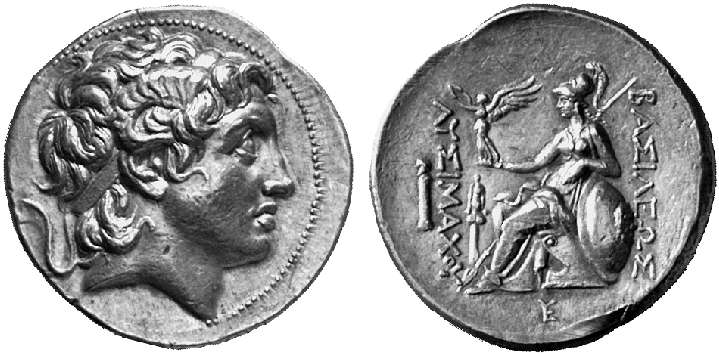Pergamum (Lysimachus), silver, tetradrachms (287-282 BCE)
From SILVER
287 BCE - 282 BCE Silver 5,654 kg
Description
| ObverseInscription or printing placed on the obverse.: | Head of divine Alexander III the Great right, wearing the Ammon horns and diadem. (In the field, Δ or K.) Border of dots. |
| ReverseInscription or printing placed on the reverse.: | ΒΑΣΙΛΕΩΣ ΛΥΣΙMΑΧΟΥ (Greek).Athena Nikephoros seated on thron left, wearing Corinthien helmet, the left arm on a shield with a lion head. Above, Nike stephanephoros. In the field, one/two symbols (crescant, pentalpha, herme, cultual statue, star) and/or a letter or a monogram. |
Mint and issuing power
| MintIdentifies the place of manufacture or issue of a numismatic object.: | Pergamum | Ancient regionAncient region.: | Mysia | Modern countryModern country: Turkey | AuthorityIdentifies the issuing power. The authority can be "pretended" when the name or the portrait of X is on the coin but he/she was not the issuing power. It can also be "uncertain" when there is no mention of X on the coin but he/she was the issuing power according to the historical sources: | Lysimachus (Macedonian officer, diadochus and king, c. 360-281 BC) |
Chronology
| FromIdentifies the initial date in a range assigned in a numismatic context. | 287 BCE | toIdentifies the final date in a range assigned in a numismatic context.. | 282 BCE | PeriodTime period of the numismatic object.: Hellenistic 323-30 BC |
Physical description
| MetalThe physical material (usually metal) from which an object is made.: | Silver |
Median weightMedian of the weights of numismatic objects (in grams). in grams | 17.00 | DenominationTerm indicating the value of a numismatic object. Examples: tetradrachm, chalkous, denarius.: | tetradrachm |
StandardStandard.: | Attic |
Image

S321 Pergamum Lysimachus.jpg [1]
References
| Die study referencePublication of the study: | Arnold-Biucchi 19981Arnold-Biucchi 1998 | ||
| Coin series referenceReference to coin series study: | |||
Obverse dies distribution
| FrequencyFrequency of specimen in distribution. ᵖ | Number of obversesNumber of obverse dies. ᵖ (o) | % (o) | Number of coinsNumber of coins. (n) | % (n) | Die nameName(s) of the die(s). |
| 1 | 1 | 6.25 | 1 | 0.79 | 5 |
| 2 | 1 | 6.25 | 2 | 1.59 | 11 |
| 3 | 2 | 12.5 | 6 | 4.76 | 14, 16 |
| 4 | 2 | 12.5 | 8 | 6.35 | 7, 15 |
| 5 | 3 | 18.75 | 15 | 11.9 | 1, 3, 4 |
| 11 | 3 | 18.75 | 33 | 26.19 | 2, 6, 13 |
| 12 | 1 | 6.25 | 12 | 9.52 | 12 |
| 13 | 1 | 6.25 | 13 | 10.32 | 8 |
| 14 | 1 | 6.25 | 14 | 11.11 | 10 |
| 22 | 1 | 6.25 | 22 | 17.46 | 9 |
| Total | 16 of 16 | 100 | 126 of 126 | 99.99 |
Reverse dies distribution
no distribution is available
Quantification
| Number of obversesNumber of obverse dies. ᵖ (o) | 16 | Number of singletons (o1)The number of singleton coins. ᵖ | 1 |
| Number of reverse diesNumber of reverse dies. (r) | 79 | Number of coinsNumber of coins. (n) | 126 |
| Coins per obverse dieNumber of coins per obverse die. (n/o) | 7.88 | Coins per reverse dieNumber of coins per reverse die. (n/r) | 1.59 |
| Reverse per obverse ratioRatio of obverse dies divided by reverse dies. (r/o) | 4.94 | Percentage of singletons (o1)number of coins (n) divided by the number of singletons (o1) ᵖ | 6.25 % |
| Original number of dies (O) (Carter 1983 formula)The estimation of the number of coins according to Carter 1983 ᵖ | 16.63 | Coins struck if 20,000 as average productivity per dieCoins made if the average productivity for obverses (according to Carter) is 20,000. ᵖ | 332,600 |
| Original number of dies (O) (Esty 2011 formula)The estimation of the number of coins according to the singleton formula in Esty 2011 ᵖ (O) | 18.33 | Survival rate if 20,000 as average productivity per dieSurvival rate if average productivity is 20,000. ᵖ | 0.00038 |
| Coverage (o = % of O) (Esty 1984 formula)Esty 1984 - coverage (% of O) ᵖ (o = % of O) | 99.21% | Die productivity if survival rate 1/2,000Average productivity if survival rate is 1/2,000. ᵖ | 15,153.34 |
| Weight of silver (in kg) if 20,000 coins per die (O = Carter formula)Carter 1983 * Median weight * 20000 (*10 if gold or electrum) ᵖ | 5,654 kg <br /> 5,654 kg | Die productivity if survival rate 1/5,000Average productivity if survival rate is 1/5,000. ᵖ | 37,883.34 |
Remarks
Most likely one single workstation
References
- ^ Arnold-Biucchi, Carmen (1998), "The Pergamene mint under Lysimachos", in Richard Ashton and Silvia Hurter (eds.), Studies in Greek Numismatics in Memory of Martin Jessop Price, London, p. 5-15, pl. 3-5 (catalog p. 6-12)